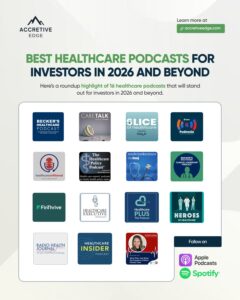What Is a Hospital Value Analysis Committee?
A hospital value analysis committee, or VAC, is a formal group that reviews new products, services, or technologies before the hospital signs a contract. These committees were created as hospitals faced rising pressure to reduce costs while maintaining or improving patient outcomes.
Most VACs ask a few core questions: Will this product improve patient care? Is it cost-justified? And can it fit into our workflows without disruption?
Think of these as the framework that helps committees decide if something is worth adopting.
1. Clinical proof
Clinical outcomes and patient safety are the first filter. VAC members want to see more than anecdotes; they look for evidence that the product is at least as effective as current options, and ideally better. Strong documentation includes:
- Peer-reviewed studies or published trials, especially randomized controlled trials if available.
- FDA clearances or approvals, including indications for use.
- Comparative data that shows your solution reduces readmissions, improves recovery rates, or lowers complication rates.
If published studies are limited (common for early-stage startups), pilot results, case series, or early deployment data can help. Transparency about sample size and limitations goes further than vague claims.
2. Financial ROI
Hospitals operate under constant budget pressure. A VAC will ask: does this product save money, increase efficiency, or at least deliver enough improvement to justify its cost? Key elements to provide:
- Cost-benefit analysis showing expected return on investment.
- Total cost of ownership across the product’s lifecycle.
- Reimbursement details, captured through Diagnosis-Related Group (DRG) and CPT codes, if applicable.
- Alignment with hospital metrics, like reducing readmission penalties or staff overtime.
One industry rule of thumb applies: if a product costs more, efficacy must be clearly better. Without a solid ROI story, committees often defer or reject requests.
3. Operational fit
Even if a product is clinically effective and financially viable, hospitals still need to know it will work in their environment. Committees want assurance that adoption won’t disrupt operations or add new risks. Evidence to include:
- Implementation timelines and training plans.
- Compatibility with EHRs and IT systems, ideally backed by HL7/FHIR or cybersecurity certifications.
- Support and warranty information.
- Case studies showing smooth rollouts in other hospitals.
It’s powerful to highlight operational benefits: fewer workflow steps, faster patient throughput, easier compliance reporting, or improved staff satisfaction. The message should be clear — this product not only fits into the hospital’s daily work, but improves it.
Together, these three pillars form the backbone of a persuasive VAC submission. Some companies distill them into a value analysis brief (VAB) — a one-page summary that highlights the most important data while keeping detailed documents available in the background.
Why Hospital Value Analysis Committees Delay Approvals
For many startups, the most surprising part of the value analysis process is just how long it can take. Even with a supportive physician champion, it’s not unusual for approval to stretch out over several months. In fact, executives frequently describe timelines of several months. In some organizations, approvals may take three to six months, while in others the process can extend toward a year.
There are a few reasons why this happens:
- Infrequent meeting cycles: Many VACs only meet monthly or even quarterly. If you miss a submission deadline, it could be weeks before your product is even discussed.
- Rising evidence standards: Case studies or marketing claims rarely carry weight on their own. Committees increasingly expect peer-reviewed research, published outcomes, or at least structured pilot data.
- Cost sensitivity: With the cost-conscious environment, finance and supply chain leaders often drive discussions. If the value story is unclear or incomplete, the request can stall.
- Need for consensus: A single unresolved concern — from IT security, quality, or finance — can delay the entire committee’s decision.
- Limited vendor input: Vendors rarely present directly. If your champion can’t answer a question in the room, it often gets deferred to a later cycle.
These delays are not intentional roadblocks. But for a startup with limited runway, waiting months for a decision can feel like a major setback. That’s why preparation is so critical.
How to Prepare for a Hospital Value Analysis Committee Review
If the VAC process feels slow and unpredictable, preparation is the best way to shorten the timeline. Startups that invest early in the right evidence and relationships are often able to move more quickly than those who wait until the last minute. Some practical steps include:
Engage a strong internal champion
Most VAC requests must be submitted by a physician or department leader, not the vendor. Having a committed champion who understands both the clinical and economic value of your product is critical. If possible, cultivate support from more than one clinician, since broad interest signals wider adoption potential.
Learn each hospital’s process
Not all VACs operate the same way. Some meet monthly, others quarterly. Some require specific application forms, others rely on internal emails. Ask your champion or supply chain contact about submission deadlines, required evidence, and common objections. Tailoring your approach to each hospital can prevent unnecessary delays.
Prepare a comprehensive VAC packet
A well-organized “VAC kit” makes it easier for your champion to present your case. Include clinical studies, cost models, product specifications, FDA documentation, training plans, and references from other hospitals. Keep the focus on evidence and comparative effectiveness, not marketing.
Craft a clear value story
Don’t assume the committee will connect the dots for you. Provide a concise executive summary that ties clinical results, financial savings, and operational feasibility into one narrative. Visuals and short tables can help the committee grasp the case quickly.
Anticipate objections
Committees often ask: what does this replace? is it a “must-have” or a “nice-to-have”? how many patients will it affect? what are the risks? By addressing these questions upfront, you reduce the chances of being deferred for more information.
Leverage pilot data and references
If you can show results from another hospital, even on a small scale, your case gets stronger. Many hospitals also prefer to run their own trial before full approval, so be ready to offer a pilot with measurable outcomes. Testimonials and references from respected clinicians or institutions also build credibility.
Streamline contracting details
Even after VAC approval, contracts can drag. Be ready with pricing models, group purchasing organization (GPO) details, and compliance documents (like insurance or data use agreements). The smoother you make the post-approval process, the faster an agreement gets signed.
Stay engaged, but patient
VACs run on hospital timelines, not startup timelines. Maintain communication with your champion, provide requested data quickly, and respect the process. Pushing too hard or trying to go around the committee usually backfires.
Preparation doesn’t eliminate the waiting, but it can cut months off the process. The more work you do upfront, the less likely you’ll be stuck cycling through meeting after meeting without progress.
The Value Analysis Committee Is Your First “Customer”
The hospital value analysis committee may feel like a black box, but it exists for a reason. Hospitals need to make sure that every new product improves patient outcomes, makes financial sense, and fits smoothly into daily operations. For startups, that can mean a slow and sometimes frustrating path — but it doesn’t have to be a lost year.
The real shift is in perspective. Instead of treating the VAC as a hurdle to clear, treat it as your first opportunity to prove that your solution belongs in the hospital. Do that well, and the committee won’t just approve your product — it may become one of your strongest advocates.






